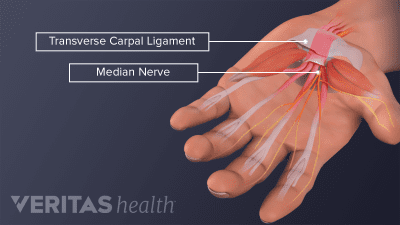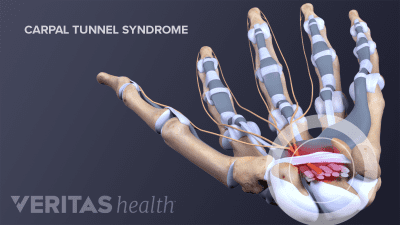Carpal tunnel syndrome reflects a clinical diagnosis that involves one of the three main nerves in the arm. The median nerve is a nerve that passes through the carpal tunnel, which is located right here. The carpal tunnel itself houses the flexor tendons of the hand as well the fingers, the thumb, and the median nerve—the nerve that passes through the carpal tunnel. Typically a patient will present with complaints of numbness and tingling, having to shake their hands in the morning. They might have complaints of numbness or tingling after typing at the keyboard or doing any repetitive motion that puts increased pressure on the wrist in either this direction or that direction.
Although the median nerve innervates the first 3.5 fingers of the hand, the patient usually does not have numbness and tingling just in that distribution. A lot of the times, they can have paresthesia within the whole hand and that sensation can vary from a frank falling asleep, to an itchiness, to feeling a need to stretch the hand, to do some type of motion, to shake the hand. A variety of those symptoms can occur.
What Causes Carpal Tunnel Syndrome?
There are about 5 or 6 main causes of carpal tunnel syndrome. Heredity plays an important role. Some people are born with congenitally small carpal tunnels. Any associated medical conditions, including rheumatoid arthritis, diabetes, and systemic conditions that may also increase the amount of fluid in the general areaa of the carpal tunnel may increase the likelihood of developing carpal tunnel syndrome.
What are the Symptoms of Carpal Tunnel Syndrome?
Patients often can present with difficulty buttoning their shirt, sometimes difficulty holding a pencil, quite often they’ll complain of dropping things inadvertently. When the symptoms are very bad, they’ll be able to see a visible atrophy and wasting of the muscles of their thumb.
How is Carpal Tunnel Syndrome Diagnosed?
In a physical examination for carpal tunnel syndrome, we’ll do a regular neurologic exam, testing the strength of all the muscles in their upper extremities, their sensation, and their reflexes. For carpal tunnel syndrome, there are a number of provocative tests also that put pressure on the median nerve, which when a person does have carpal tunnel syndrome will be positive. Also in the physical examination, this is a chance to rule out when the numbness and tingling is not coming just from carpal tunnel but also from other nerves, most often the neck.
In terms of diagnosis, the most objective way to diagnose carpal tunnel syndrome is to do an EMG and nerve conduction study, which provide a way to measure the degree of carpal tunnel syndrome (to classify as mild, moderate, severe) and also to rule out if there are any other associated, number one, compressed nerves, or if there’s an associated and irritated nerve that’s coming from the neck.
The easiest way also to look at carpal tunnel syndrome is to imagine that your hands are like light bulbs. When the light bulbs are going off in your house, that example can be related to the sensation of numbness and tingling in your hands. Sometimes that light bulb goes out when there’s something wrong with the light bulb itself, but sometimes it can go out because there’s something wrong with the power supply. So when evaluating for carpal tunnel syndrome, you want to see if it’s just the light bulbs, where the median nerves are specifically irritated, or if there is anything also going on with the power supply. The EMG and nerve conduction studies are good to tell that.
Recommended for You








